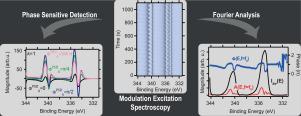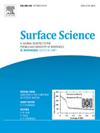Comparing phase sensitive detection and Fourier analysis of modulation excitation spectroscopy data exemplified by Ambient Pressure X-ray Photoelectron Spectroscopy
IF 2.1
4区 化学
Q3 CHEMISTRY, PHYSICAL
引用次数: 0
Abstract
Dynamic processes in catalysis are gaining increased attention and could very well be one of the next frontiers in surface science. One way to study such processes is to induce chemical changes on the surface for example by periodically adjusting the (electro)chemical potential in situ and identify the resulting spectral changes. Often this is referred to as Modulation Excitation Spectroscopy (MES). Using Ambient Pressure Photoelectron Spectroscopy data, we here discuss and compare the analysis of MES data using both Phase Sensitive Detection (PSD) and Fourier analysis. We discuss that PSD determines the component magnitude at a user-defined phase value while Fourier analysis provides the maximum oscillation amplitude and respective phase value of oscillating spectral features. We discuss advantages and disadvantages of the different analysis schemes and explore how the full time-evolution can be obtained.

以常压 X 射线光电子能谱为例,比较相敏检测和调制激发光谱数据的傅里叶分析
催化的动态过程越来越受到关注,很可能成为表面科学的下一个前沿领域。研究此类过程的一种方法是诱导表面发生化学变化,例如通过在原位定期调节(电)化学势,并识别由此产生的光谱变化。这通常被称为调制激发光谱(MES)。利用常压光电子能谱数据,我们在此讨论并比较使用相敏检测(PSD)和傅立叶分析对 MES 数据进行的分析。我们讨论了 PSD 可确定用户定义相位值的分量幅度,而傅里叶分析可提供振荡光谱特征的最大振荡幅度和各自的相位值。我们讨论了不同分析方案的优缺点,并探讨了如何获得完整的时间演变。
本文章由计算机程序翻译,如有差异,请以英文原文为准。
求助全文
约1分钟内获得全文
求助全文
来源期刊

Surface Science
化学-物理:凝聚态物理
CiteScore
3.30
自引率
5.30%
发文量
137
审稿时长
25 days
期刊介绍:
Surface Science is devoted to elucidating the fundamental aspects of chemistry and physics occurring at a wide range of surfaces and interfaces and to disseminating this knowledge fast. The journal welcomes a broad spectrum of topics, including but not limited to:
• model systems (e.g. in Ultra High Vacuum) under well-controlled reactive conditions
• nanoscale science and engineering, including manipulation of matter at the atomic/molecular scale and assembly phenomena
• reactivity of surfaces as related to various applied areas including heterogeneous catalysis, chemistry at electrified interfaces, and semiconductors functionalization
• phenomena at interfaces relevant to energy storage and conversion, and fuels production and utilization
• surface reactivity for environmental protection and pollution remediation
• interactions at surfaces of soft matter, including polymers and biomaterials.
Both experimental and theoretical work, including modeling, is within the scope of the journal. Work published in Surface Science reaches a wide readership, from chemistry and physics to biology and materials science and engineering, providing an excellent forum for cross-fertilization of ideas and broad dissemination of scientific discoveries.
 求助内容:
求助内容: 应助结果提醒方式:
应助结果提醒方式:


